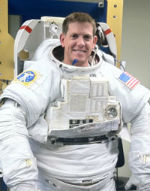
At the age of 17 he was given the chance to fly to the United States and join an International Space School at NASA's Johnson Space Centre (JSC) in Houston and a seed was sown.
Andrew had never been on an aeroplane before but after spending two weeks at NASA, he knew he’d found his dream job.
Now with over a decade’s experience in the Space Life Sciences and Engineering Directorates at the Johnson Space Centre under his belt, Andrew is deputy project manager for a team responsible for designing and testing a next generation vehicle for space exploration - the Multi-Mission Space Exploration Vehicle (MMSEV).
About the MMSEV
The MMSEV started life as a moon vehicle called the Lunar Electric Rover but a more flexible design is now being developed, so that variations of the same vehicle can be used for in-space missions, as well as for surface exploration on asteroids and Mars.

From the Arctic to the Arizona desert
Andrew says that the most enjoyable part of his job is testing new hardware and exploration techniques in remote locations.
We build and test prototypes on earth so that we understand exactly how we will build and operate the flight vehicle before we actually start building the flight vehicle.
Dr Andrew Abercromby
Analogue missions are part of our iterative design-build-test cycle, and let the team test prototype systems and operations in environments that are similar to space. Underwater testing and parabolic flights let us simulate weightlessness or reduced gravity, we sometimes use virtual reality environments, and we often use the desert to simulate the moon or Mars. We build and test prototypes on earth so that we understand exactly how we will build and operate the flight vehicle before we actually start building the flight vehicle. Spending a relatively small amount of time and money on ground prototypes in the early stages can really pay off in the long term because it can cost a lot of time and money when you change your mind about even a small aspect of your design when you are already in the middle of building a spacecraft.
This approach allows design requirements to be refined during early development, and has taken Andrew from the Arctic to the Arizona desert.
Finding NEEMO
He cites his favourite exploration research mission to date as NEEMO 14 in May 2010, where he spent two weeks in Aquarius, the world's only undersea research laboratory - a unique experience during which he celebrated his 30th birthday.
For more information on Andrew’s work please visit:
NASA's Space Exploration Vehicle (SEV)

